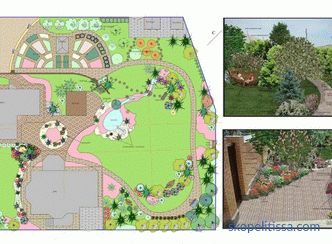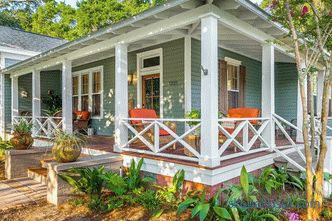Exterior decoration of the house serves not only for decorative purposes. It helps to ensure the durability and integrity of the material of the walls and, in particular, the basement section of the foundation. There is a wide range of materials that allow you to create a solid and reliable protective shell of the external surface of the facade. This article describes the nuances and difficulties of finishing the basement of a private house with siding. Information will help to get an idea about the material, installation technique and other features of the basement siding, which will allow you to competently talk with sellers or installers of plating.
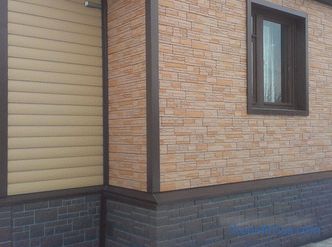
What is a basement siding
Siding is a type of exterior plating that forms dense and hermetic canvas with high decorative qualities. Initially, only wooden siding was used, which is a narrow oblong panel, installed mainly in a horizontal position. Over time, wood was replaced by more practical vinyl and metal sheet, although the surface externally imitated wood details - timber, log, ship lining, etc.
Ground siding appeared a little later. According to the manufacturers, the finished walls should have been complemented by the design of the basement basement section. This allowed us to obtain a harmonious exterior wall decoration of the house, repeating the traditional structure of a wooden house with a stone basement.
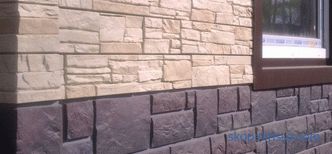
to create contrast and visual cut-off of walls from the basement When creating panels, the drawbacks were taken into account wall varieties of material. In particular, the shape of the panels, which has become close to rectangular, with cutouts for the formation of invisible joints, has been changed.
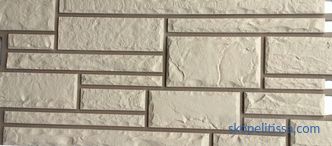
Changing the configuration of the panels simplified installation and reduced the number of components. In addition, the decorative effect of the basement siding linen was much more significant, which expanded the scope of use of the material.
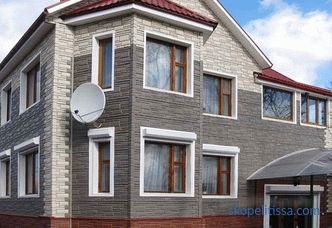
Lack of vertical joints, high realism of material simulation The overall information content of the finishes was appreciated. At present, the material is often called facade panels, which expands its scope of application. Plinth siding, the installation of which is simple and does not take much time, has become more preferable than traditional types of wall covering.
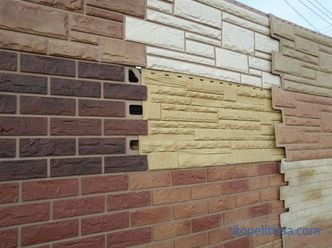
Types of basement siding
Ground siding can be divided into several varieties. By the material used is:
-
Metallic .
-
Plastic siding .
Plastic panels, in turn, are divided into the following subspecies:
-
Vinyl .
-
Polypropylene .
-
Polyvinyl chloride .
Vinyl panels are the most common. They have a significant advantage over metal, which are prone to corrosion, do not have elasticity and do not return to their former shape when mechanical loads appear. The basement is the lower tier of the house, where the possibility of various impacts is multiplied. Dents and scratches on the surface of the canvas greatly spoil the appearance of the skin.
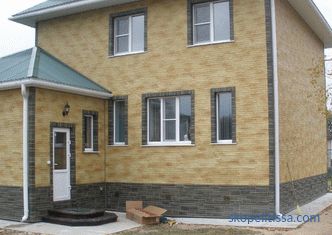
On our site you can read the most popular in Moscow suburbs areas for the construction of a country house . In filters you can set the desired direction, the presence of gas, water, electricity and other communications.
Advantages and disadvantages
Ground siding has significant advantages:
-
House covering with ground siding allows you to get a stylish and solid appearance houses.
-
When setting the material , no wet solutions are used.
-
Works can be performed on a well-maintained site without prejudice for design elements.
-
The cost of basement siding is much lower than natural materials, and the result is almost indistinguishable.
-
There is a wide selection of colors and simulation materials.
-
The material is accompanied by a full set of complementary (additional) parts required for installation and making out corners, transitions and gaps.
-
The casing can be of any size without vertical seams, which distinguishes the socle siding from the usual wall siding.
-
It is possible to insulate the wall or plinth, to create a ventilated facade without significant changes in installation technology.
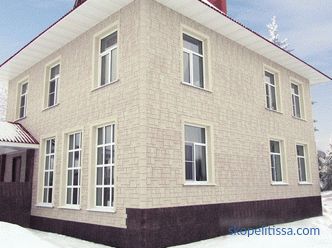
The disadvantages of basement siding are:
-
The technology of mounting the walls of the house with the base siding requires taking into account a high coefficient of thermal expansion. This is especially true for vinyl panels.
-
In frost plastic types of panels become fragile and may burst under mechanical stress.
-
Some types of panels emit a noticeable smell , which is intensifying on hot summer days.
-
In the event of a fire the panels melt , although they do not light up.
Material deficiencies are considered insignificant and are many times compensated for by high visual appeal, ease of installation, and relatively low price.
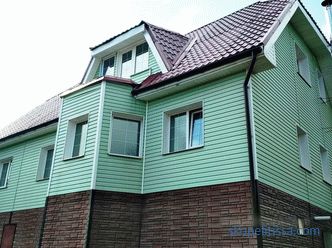
It can be interesting! In the article on the following link read about artificial stone for the base - types of material, installation steps .
Composition and accessories
In addition to the main panels forming the sheathing fabric, the basement siding is completed with additional elements:
-
Starting and finishing bar .
-
Corner bar .
-
Internal and external angle .
-
Window bars .
-
Low tides .
-
Platbands .
-
Spotlights .
-
Eaves levels .
In addition to these elements, materials should be included in the kit to create a batten. These are wooden strips or metal guides for drywall, forming a flat vertical plane on which the panels are mounted.
All elements perform their own functions - some serve as supporting structures, others draw transitions or corners, and are installed on curtain rails or openings. Houses, finished with basement siding, look very attractive due to the lack of empty seats and accuracy of the adjoining design.
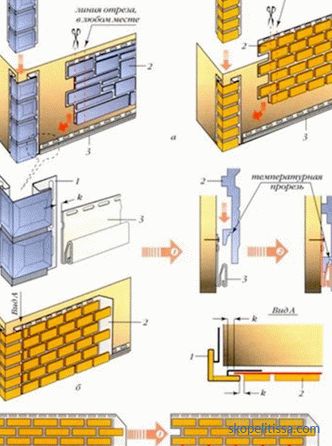
Mounting technology
Finishing the foundation of the house with siding is done in stages. Consider the usual procedure:
Acquisition of material
The start of work consists in the acquisition of all materials. You will need:
-
Panels .
-
Additional elements .
-
Planks for creating crates.
-
Direct suspensions for drywall or suspended ceilings.
-
Self-tapping screws galvanized with flat caps.
The choice of the most suitable material can be made independently, but it is better to entrust this procedure to people who are to install. They have the experience and will buy exactly those elements and materials that are needed.
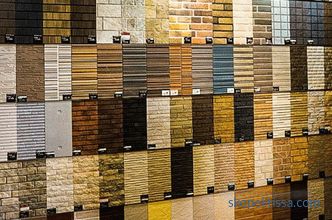
It might be interesting! In the article on the following link read about calculation of siding and components for covering the house .
Surface preparation
Preparation consists of removing all foreign objects from the base surface, including brackets, flashlights, and various attachments. Then it is necessary to inspect the surface and seal up all the detected flaws - cracks, hollows, etc. After this, a deep penetration primer is applied (if insulation is planned), or a special waterproofing impregnation is applied.
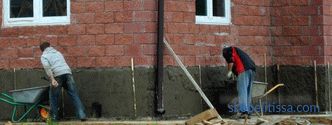
Install the batten
The batten is carrier construction installation siding. In parallel (if necessary), it performs the role of supporting structure for the installation of insulation.
The installation of the batten was traditionally made from wooden bars, but their qualities are not high enough compared to the metal guides from gypsum board. Their price has recently dropped significantly, making the material affordable and most preferred.
The installation of the batten is performed in such a way that the distance between the planks corresponds to the location of the mounting holes in the panels. Installation of insulation is carried out in parallel with the installation of sheathing, direct suspensions are conducted through the panels and do not interfere with the formation of a dense and hermetic layer of insulation.
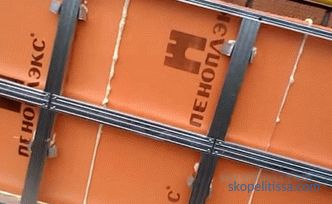
Installation of the panels
Installation of the panels is carried out immediately after the installation of the supporting elements - starting strips, corner slats, etc. The panels are fixed in direction from left to right.The first panel is cut in a straight vertical line, the rest set in the corresponding cutouts. An important condition for installation is loose fitting parts, they should hang out a little on the screws. This is necessary for unimpeded web movements during temperature expansions.
For the design of window or door openings, the corresponding elements are used; vnatyag ". Screws must be screwed in the center of the elongated mounting holes to allow small movements in both directions.
In the video you can see the installation of base siding:
It can be interesting! In the article on the following link read about a house project with a wavy roof .
Conclusion
Summarize what has been said. Plinth siding is a versatile material that allows you to finish only the plinth plots or the entire wall. The appearance of this finish is very attractive, the house gets a solid and respectable appearance. Installation of the material is simple, the only fundamental condition is the requirement to loosely fasten the parts to the crate, therefore, it is usually not expensive to do the installation work. Spending time and money are relatively small and well worth the result.


